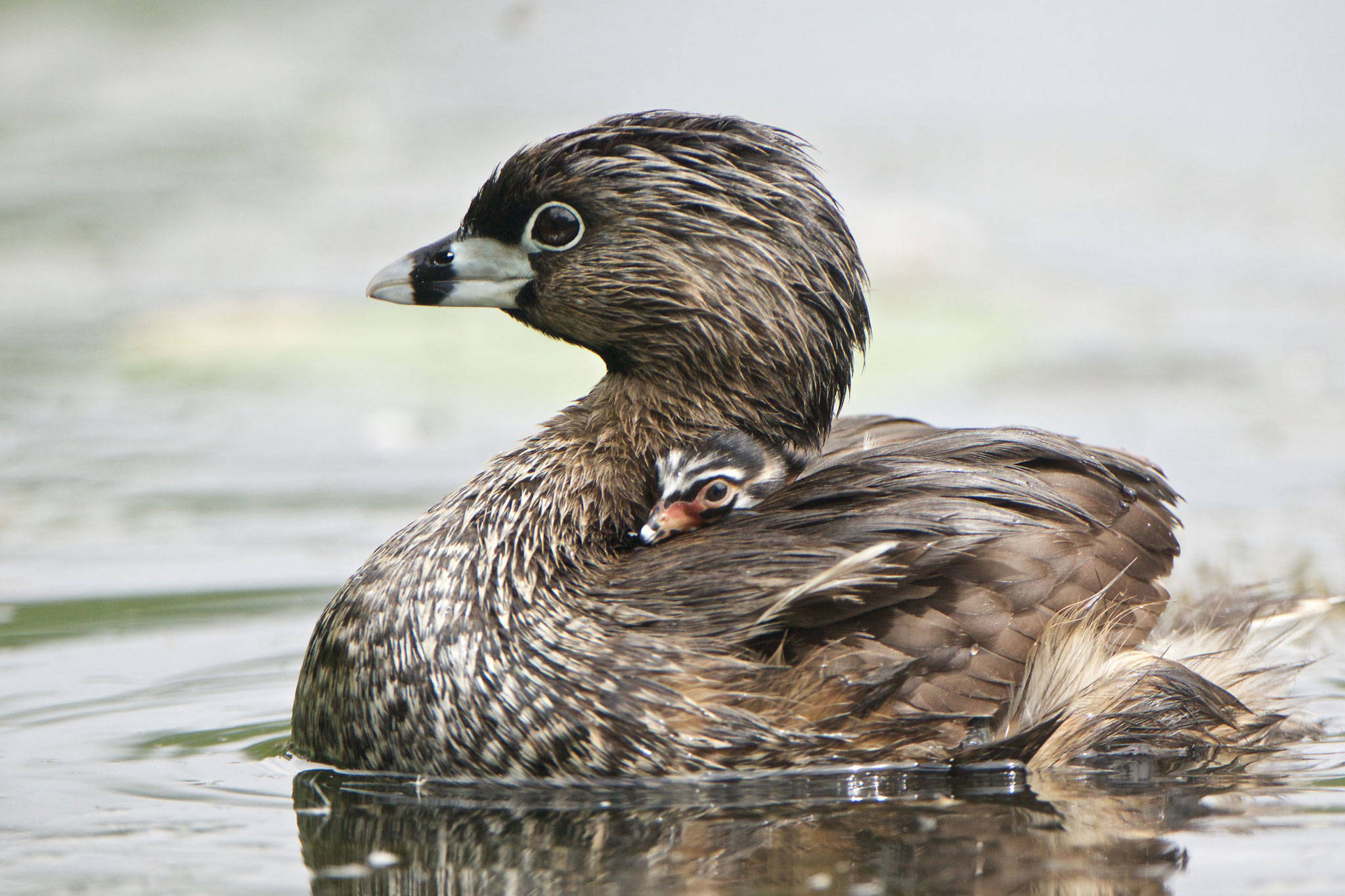One of my favorite zoo animals as a kid was the gibbon, especially when they began hooting; the sound carried all across the zoo. So imagine my surprise when I heard what sounded like a gibbon….on Duck Lake in Ocean Shores. I knew that wasn’t possible, and never did see the creature making the noise. Fast forward a few years when looking up the Pied-billed Grebe and hitting the sound button, and there it was…my gibbon sound. Enjoy this photo by Gregg Thompson, and if you want to hear this bird, here is a link. https://www.allaboutbirds.org/guide/Pied-billed_Grebe/sounds
General Description: The Cornell Lab of Ornithology describes the Pied-billed Grebe as “part bird, part submarine” for their ability to swim underwater. They are small, chunky birds, grayish-brown in color with lighter underparts, most often found in fresh water. Both sexes measure 12 to 15 inches in length, have a wingspan of 18 to 24 inches, and weigh between 9 and 20 ounces. They have a short but heavy bill that sports a black stripe around it during the summer breeding season. They are hard to spot as they usually stay among the water plants. Their feet are located far back on their body to allow better swimming, but they don’t walk well on land.
Habitat: Pied-billed Grebes are fresh-water birds that are found year-round in Grays Harbor. They can be found on sluggish waterways such as marshes, lakes, ponds, slow-moving rivers, and yes, even sewage ponds, from sea level up to 8,000 ft. altitude. They forage among plants that are anchored on the bottom but with leaves in the air, and build nests among the plants.
Behavior: This grebe isn’t as social as other grebes, so you won’t find them in a flock but one or two in a pond or in the same area is not uncommon. They both feed and escape perceived danger by diving, or they may even slowly submerge from view except for their eyes and nostrils. But their most famous move is a crash dive, plunging with head and tail raised above the belly, making a splash. Like other grebes, they need a long, running start to get off the surface of the water.
Diet: The Pied-billed Grebe eats crayfish, small fish, crabs, shrimp, snails, mussels, beetles, dragonfly nymphs, and aquatic insects and their larvae. Their bill and jaws are strong enough to crush shellfish. Like other grebes, they also feed their own feathers to their young, and eat them themselves, perhaps to aid in eliminating undigested bones from previous prey.
Nesting: Pied-billed Grebes typically build their nests among emergent plants anchored to the mud on the bottom of a marsh, or on top of a floating mat of vegetation. Both sexes build the nest, which can be approached from underwater. Both parents incubate 5 to 7 eggs for approximately 23 days. If they leave the nest they will cover it with vegetation to hide the eggs and to keep them at a near-constant temperature. Pied-billed Grebe chicks typically leave the nest the first day after hatching and spend much of their first week riding around on a parent’s back. They usually spend most of their first 3 weeks on or near the nest platform.
Migration: These birds don’t migrate much distance unless their habitat water freezes, then they move south until they find a place where the water isn’t frozen. Most stay in place year-round.
Conservation Status: Pied-billed Grebes are common and wide-spread. Habitat loss is the major threat, although Pied-billed Grebes will nest in created and restored wetlands, and in sewage lagoons.
When and Where to Find in Grays Harbor: I often find these grebes year-round on Duck Lake in Ocean Shores and all the local fresh-to-brackish waterways in the area. In winter resident populations increase as local birds are joined by northern migratory birds, which begin arriving in western Washington in September and October. Eastern Washington migratory breeders are typically gone by December and return in late March or early April. They are very secretive, so prepare to wait a while to see them, or listen for the hooting gibbon!


